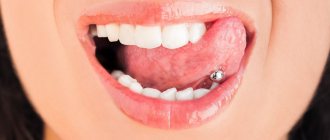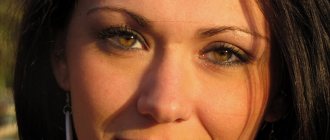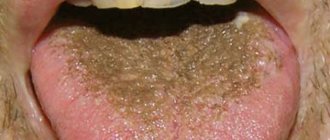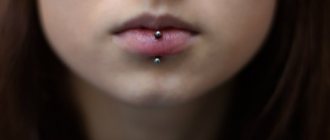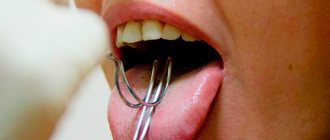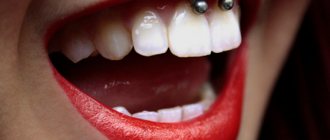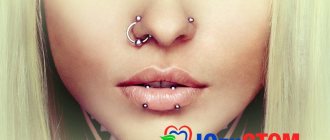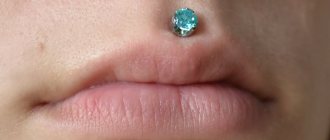Tongue piercing is one of the most popular types of piercings. Lots of young people get tongue piercings.
What are the benefits of tongue piercing?
- Unusual, erotic, shocking, very fashionable.
- Heals quickly.
- There is no trace of the piercing left, the channel is healed within a day.
Tools for tongue piercing: tongue holder or oval window clamp, catheter needle No. 16, No. 18.
Earrings: for the first puncture and healing, it is better to use a polyethylene barbell earring, 18-19 mm long. This is a length with a margin for tongue swelling. After 3-6 weeks, when the canal is fully formed, the barbell can be changed to another (14-16 mm).
Attention! If you have gold crowns in your mouth, then you cannot wear steel piercing jewelry for a long time. A “galvanic couple” occurs, and constant irritation of the mucous membranes is possible. In this case, you need to use plastic or titanium tongue decorations.
Treatment before piercing the tongue: the mouth should be rinsed with a 3% (diluted 1:1 with water) hydrogen peroxide solution. Rinse - 5 minutes. A banana earring with an unscrewed ball should be immersed in an antiseptic solution for 15-20 minutes (95% alcohol, disinfectant solutions).
Place of tongue piercing: the main landmarks are the central line and the frenulum of the tongue. The injection point is located under the tongue in the midline, without affecting the frenulum.
Types of tongue piercing
There are four types of tongue piercing:
► Vertical - from the frenulum to the palate. Classic and most common puncture.
► Horizontal - the puncture is located on the tip of the tongue, from ear to ear (wide)
► Superficial - the puncture is made across the tongue
► Tongue frenulum piercing – piercing under the tongue
Problems and inflammation
The main problems with tongue piercing healing are improper care, lack of oral hygiene, or the consequences of a healing process aggravated by colds.
The consumption of alcohol and other vasodilators leads not only to an increase in blood pressure, but also to a decrease in basic immune functions. Their oppression will have an extremely negative impact on healing and all the ensuing processes. It is worth knowing that lactose (dairy products) with reduced immunity and a general inflammatory process during the healing of the piercing can cause candidiasis.
Be careful with general hypothermia and being in ventilated rooms. Any colds, viral, mild or acute infectious processes have an extremely negative impact on recovery.
Protect yourself from mechanical damage at least for the first 3 weeks. The cracks formed from them can become an easy and quick way for microorganisms unnecessary for healing to penetrate into the wound cavity.
Choosing jewelry for piercing
Jewelry for tongue piercing must be made of high-quality material - titanium . Medical steel, gold, silver and other metals contain foreign alloys, which, when in the human body, begin to oxidize, and in the oral cavity this process is much faster, so the consequences after tongue piercing with such jewelry will be very unpleasant. For primary healing, 1.6x22 rods are used (sometimes longer, based on individual measurements of the tongue); a shorter rod can be replaced 2-3 weeks after the puncture. For those who really want a tongue piercing, but have not yet decided, there is a tongue piercing - such jewelry is held on by suction cups or magnets.
Healing
From two weeks to a month. Rapid healing is due to the microflora of the oral cavity and good blood circulation.
Care
Remember that the oral cavity, especially the tongue muscle, has strong blood circulation. In this regard, after the piercing procedure, the entire perimeter of the tongue tends to react with swelling, both moderate and severe. This is a temporary reaction. The swelling subsides on the 4-6th day after the procedure.
In addition to general care, a primary liquid diet is extremely important. Nominally, consumption of dairy products, baby food, liquid cereals, pureed soups (from the 3-4th day). You should refrain from any serious taste and thermal irritants such as spicy, bitter, very salty, sour, hot or very cold foods, in order to avoid irritation of the wound surface and slow down the recovery process. You can return to your normal diet from the 6-7th day after the procedure, doing this gradually.
For general care, the antiseptic Miramistin is optimal. Rinse should be done after every meal and after brushing your teeth. It will not be superfluous to rinse with purified water after eating food and brushing your teeth, so as not to leave food and toothpaste residues near the wound surface.
Rinsing should last no more than 3 weeks. Remember that even such a mild oral antiseptic as Miramistin can have a slight “rinsing” effect on your own microflora, depriving it of some regenerative and immune abilities. The environment is not sterile and must resist foreign microflora.
Puncture procedure
First of all, the master helps you choose jewelry. For initial healing, a 1.6x22 bar is placed in a classic tongue piercing; this is a standard size, which, in case of swelling after the piercing, will prevent the jewelry from digging into the tongue. Wraps are selected for the bar depending on the client’s preferences. Next, the master gives the client to rinse his mouth with octenisept and makes markings, looking at the anatomy of the tongue. After this, sterilized instruments are taken out, the tongue is held with a special round clamp and a puncture is made with a piercing needle, with the help of a taper the jewelry is smoothly inserted and the screw is screwed on. After the piercing, your tongue will hurt and swell, but you shouldn’t be afraid of this; the pain will go away quickly if you follow all the recommendations that the master will give you.
What to Avoid While Your Tongue Heals
What to avoid:
- Hard, sour, sticky, spicy foods.
- Talk too much.
- Kissing and any other use of the mouth with girlfriends/friends
- Putting foreign objects in your mouth.
- Smoking (it’s better to abstain at first, and once the piercing heals, then quit smoking altogether)
- Experiment with tongue decoration (you will have plenty of time for this after healing)
The swelling should go down in a couple of weeks, but the healing period may take longer.
Once pierced, the tongue usually takes three to four weeks to completely heal. This is one of the fastest-healing piercings as the enzymes in saliva help fight infection and kill bacteria.
This is interesting: Everything About Ear Piercing
You will need to use a good non-alcoholic mouthwash to help clean your mouth, but be careful not to over-clean, which can cause your tongue to turn green or brown. If this happens, simply reduce the amount of mouthwash you use and how often you use it.
- Days 1-5: After the first day, you will experience bloating. This will be worse during the first five days, when your speech will be impaired and you may have to change your diet to mashed potatoes, noodles, and other soft foods. Drinking cold drinks helps. For faster healing, you should avoid drinking alcohol or hot drinks, smoking, kissing, fiddling with or even touching a barbell, and ibuprofen and aspirin (which can increase swelling—use Tylenol instead).
- Days 5-7: The swelling will begin to decrease. Some people recover faster than others.
- Days 7-10: Swelling should go down now. When this happens, you need to have the bar replaced with a shorter one. The day you can replace the long barbell with a shorter one will depend on the amount of swelling you experience.
- Day 10-28: It may take 3 to 4 weeks to heal completely.
When can I remove the jewelry from my tongue and for how long?
The answer to this question varies from person to person. Tongues heal quickly, and even if the piercing is technically healed, it will also heal and close if you leave the jewelry out for an extended period. Some piercings can heal closed almost immediately in a day or two, while others with established piercings say they can go without jewelry for up to three weeks, don't worry.
This is interesting: All about Nipple Piercing
Tongue piercing care
In order for the piercing to heal well, you need to know how to care for your tongue piercing. Caring for a tongue piercing includes constant treatment of the oral cavity - Lakalut, Asepta or President rinses ; you need to rinse your mouth 4-5 times a day and after each meal and drink. Swelling after tongue piercing lasts at least 4-5 days, so during this time you will have to refrain from active conversations, hard, spicy and salty foods .
If you notice that plaque has appeared after your tongue piercing, you should not try to remove it, as you will injure the piercing. After 2-3 weeks, you can change the barbell to a shorter one (downsize).
Rules for handling a pierced tongue
The long dumbbell can be replaced with a shorter dumbbell after at least ten days to avoid recurrence of tongue swelling. It is imperative to remove the formed plaque from the tongue and jewelry every day. A soft toothbrush is great for this. Cooled water, which it is advisable to drink every morning, will help reduce swelling on the tongue. In the first days after tongue piercing, you need to speak as little as possible, since unnecessary movements of the injured tongue and dumbbells can disturb the wound and cause bleeding from it.
To prevent swelling from increasing, during the healing period it is necessary to avoid spicy foods and hot liquid foods - soup, tea, coffee. Alcohol is also temporarily contraindicated.
It is also not recommended at the initial stages of healing to feel the dumbbell with the tip of your tongue and try to “play” with it - this will slow down the process of tissue regeneration and can provoke the formation of scars. It is also not recommended to remove the dumbbell, since the puncture of the tongue will heal very quickly and everything will have to be done anew. You should abstain from oral sex for at least fifteen days - kissing should also be postponed until the puncture is completely tightened.
How to deal with complications after a piercing
At the first signs of improper healing, you should contact your doctor or consult with a specialist. Timely seeking help will help avoid serious consequences and stop the pathological process.
Before visiting a doctor, you can:
- wipe the area with the decoration with an alcohol solution;
- apply a cotton swab soaked in an antiseptic (for example, Furacilin or Chlorhexidine) to the wound;
- apply a gauze swab lubricated with Levomekol or Tetracycline ointment.
Consequences of unsuccessful ear piercing
Earlobe piercing rarely causes complications; problems most often arise when the cartilage is pierced. Cartilaginous tissue takes a long time to heal, painfully, and often rejects the earring and festers. Benign tumors can form on them, which need to be removed surgically. Unsuccessful piercing can lead to drooping ear cartilage, which will have to be corrected with plastic surgery.
There are many nerve endings in the ear area. If they are hit, it can cause facial paralysis. If the piercing procedure is seriously violated, hearing loss may develop.
How long does it take for a piercing to heal and how to understand that complications have arisen
A fresh puncture goes through three stages: inflammatory, active healing and restorative. The duration of each stage depends on the location where the hole is made. For example, a nose piercing takes 1-2.5 months to heal, an eyebrow piercing takes 2-3 months, and a tongue piercing takes 3-4 months. Read more about healing times in our separate article.
The first signs will help you understand that complications have begun to develop in the puncture area:
- too much redness in the puncture area;
- itching;
- pain;
- feeling of heat in the wound area and increased body temperature;
- purulent discharge.
FAQ
- Are there any contraindications to piercing?
Yes, I have. A puncture cannot be done if you have a number of diseases: diabetes, AIDS and HIV infection, viral hepatitis, herpes, mental disorders, epilepsy, oncology. Also, the procedure is not performed during pregnancy or lactation.
- Which area is the most painful to pierce?
It all depends on the individual pain sensitivity threshold. It is believed that the most severe pain is caused by piercing the nipples, ear and nose cartilage. The least painful puncture is in the earlobe.
- What jewelry material does not cause allergies and complications?
For the initial puncture, jewelry made of safe hypoallergenic titanium, medical steel, polytetrafluoroethylamine (PTE/PTFE), bioflex, and acrylic are recommended.
Share link:
